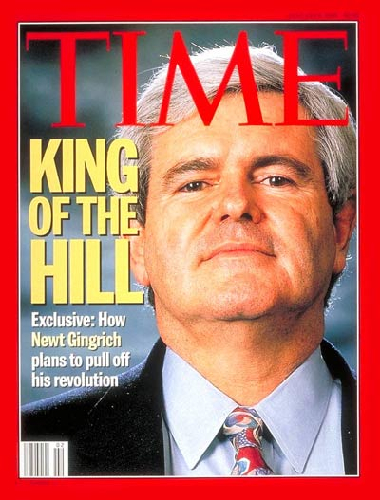 When a story's headline is as ambitious as "Why Newt Gingrich Converted to Catholicism," a reader might hope for a meaty report that addresses the question with insights from friends rather than with speculation. Amy Sullivan's report for Time mostly does not deliver, except for a few good quotations from the convert himself and from his third wife, Callista.
Sullivan perceives Gingrich's conversion with witty skepticism, and that's fair. She points out his historic non-interest in abortion and school prayer, his gestures toward a presidential bid and his quirky piety, which does not rule out his dipping into a novel while waiting for a Mass to begin at the Basilica of the National Shrine.
When a story's headline is as ambitious as "Why Newt Gingrich Converted to Catholicism," a reader might hope for a meaty report that addresses the question with insights from friends rather than with speculation. Amy Sullivan's report for Time mostly does not deliver, except for a few good quotations from the convert himself and from his third wife, Callista.
Sullivan perceives Gingrich's conversion with witty skepticism, and that's fair. She points out his historic non-interest in abortion and school prayer, his gestures toward a presidential bid and his quirky piety, which does not rule out his dipping into a novel while waiting for a Mass to begin at the Basilica of the National Shrine.
I believe Sullivan's report falters most in this segment, about midway through:
Unlike Evangelicals, for whom conversion is often an emotional, born-again experience, Catholic converts tend to make more of a considered decision to join a theological and intellectual tradition. "Conservatives are especially receptive to the promise of there being some capital-T truth that one can embed one's convictions in," says Damon Linker, a former editor of the Catholic journal First Things.
Gingrich describes the appeal of Catholicism for him in just these terms. "When you have 2,000 years of intellectual depth surrounding you," he told me on a recent summer morning, "it's comforting." There's also cachet in conservative political circles to being Catholic. Until their deaths in the past year, Father Richard John Neuhaus and National Review founder William F. Buckley Jr. presided over an intellectual haven for conservatives put off by Evangelicals who rail against experts and élites.
Here we have two generalizations broad enough to accommodate a few tanks, driving side by side: Evangelicals' conversions are often emotional rather than considered, and evangelicals (with no qualifying often this time) rail against experts and élites. Claiming that Neuhaus provided an intellectual haven from these unnamed evangelical populists is especially rich, considering that Neuhaus was a chief architect of the long-lived Evangelicals and Catholics Together project.
I do not doubt that significant numbers of evangelicals experience emotional conversions, or that some are skeptical of experts and élites. Sullivan never establishes, however, that Gingrich was ever drawn toward evangelicalism, or what specific great truths drew Gingrich into Catholicism. Rather, she implies that his conversion had as much to do with his wife's insistence on attending Mass regularly.
Sullivan neglects a trickier question: Did the circumstances of Gingrich's two previous marriages pose any difficulties for a church that still attaches disciplines to its teachings against divorce?
Sullivan strikes the right tone of tentativeness about what Gingrich's faith will mean for his political future. That makes the rabbit trail about evangelicals especially strange, and gives this story an unfortunate odor of blowing smoke.
Image: Newt Gingrich's first of five appearances on the cover of Time, Jan. 9, 1995.
